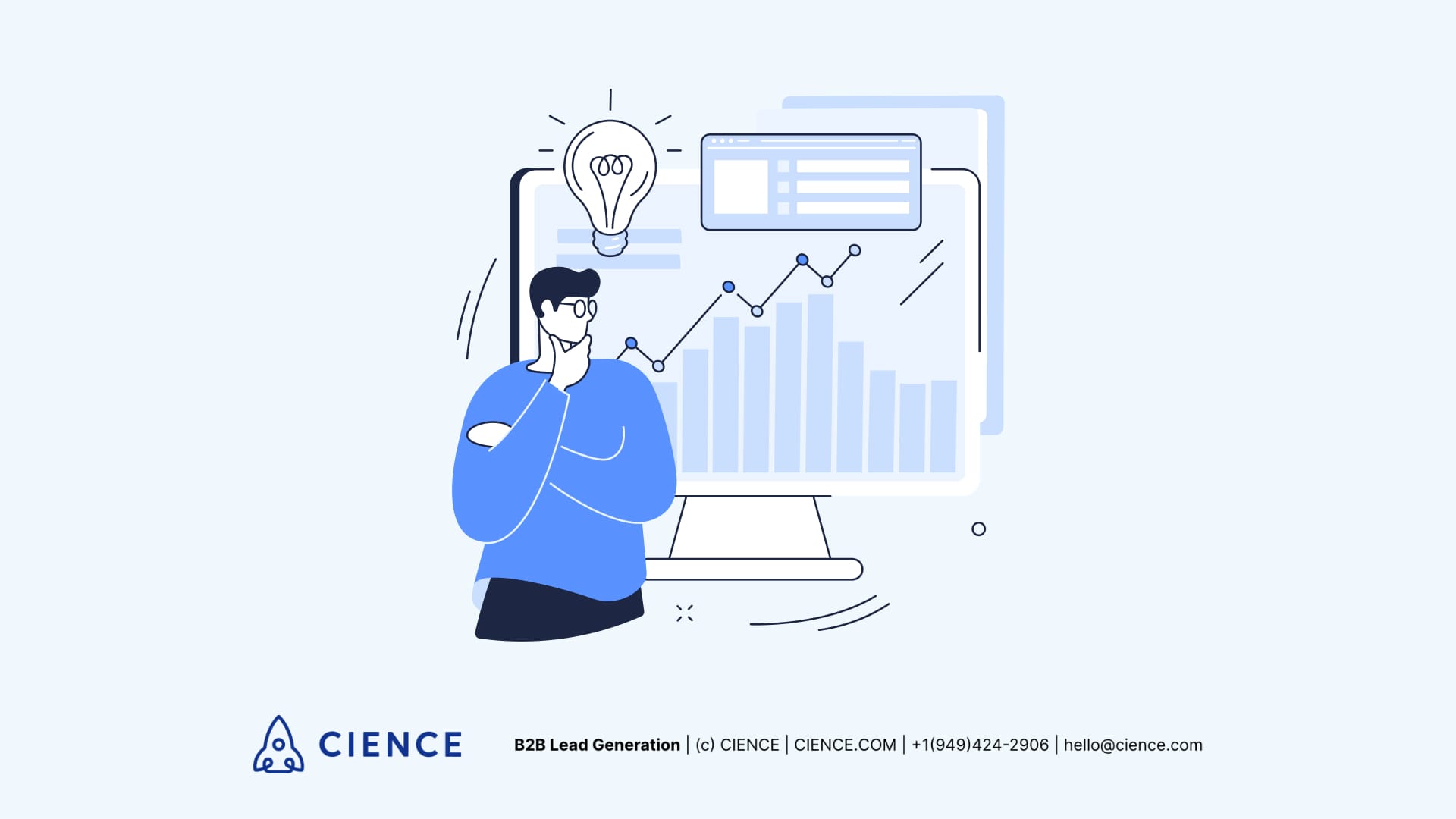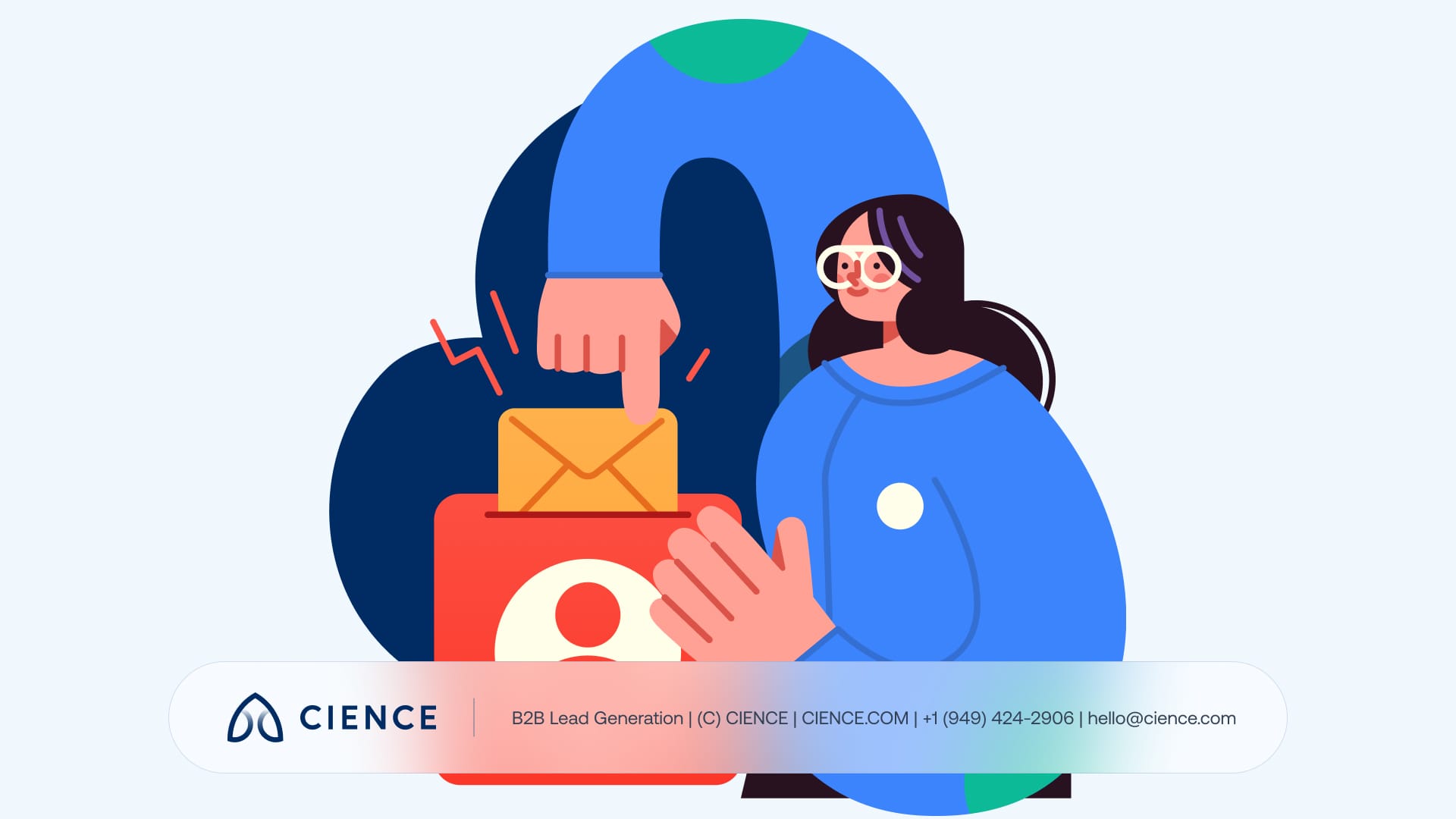(Making the Most of) Inbound Marketing Strategy
Unveiling the Mysteries of Source Attribution: Inbound Marketing Strategy Insights from CIENCE
In the intricate dance of digital marketing, understanding the origins of your inbound leads is not just pivotal—it's strategic. By discerning these origins, businesses can:
- Control CAC,
- Invest in “winners”,
- Cut “losers”, and
- Optimize lead channel effectiveness.
With businesses heavily investing time, effort, and resources into their inbound marketing strategies, several pressing questions arise:
- Where do potential clients and partners first hear about us?
- How do they embark on their journey toward engagement?
- What touch points influence their decision to reach out?
- Are there hidden channels of influence we're overlooking?
To answer these questions, we’re delving deep into CIENCE's own data, aiming to illuminate the often-mysterious pathways that guide prospects to our doorstep.

Background
We wanted to go beyond the Google Analytics and Marketing Automation Platform “blind spots” where the top channels of Inbound are typically:

- Direct Traffic
- Email Marketing
- Organic Search
- Other
- Paid Search
- Paid Social
- Referrals
- Organic Social
While these eight channels offer a broad segmentation, they often provide a vague view of inbound traffic. The "Direct" category is particularly muddled, and channels like Organic Search and Organic Social remain opaque due to restrictions from platforms like Google that prevent revealing specific user searches. Organic Social sites (especially Linkedin) are also of this ilk, too.
It's worth noting that these two categories, despite their vagueness, often dominate as sources of Inbound traffic, except for businesses with significant advertising budgets or those exceptionally skilled in social marketing.
So, for the CMO’s out there thinking… I wish there was a better way! I submit to you the following idea:
How did you hear about us?
Simple 1-line question that you can include on any standard form. Sure it’s a custom field, but it can be illuminating, as I’m about to show.
At CIENCE, we recently undertook a meticulous analysis of 4K inbound leads (3,997 to be exact) from the past year. Although this doesn't encompass even a majority of our inbound leads (this question isn’t mandatory on forms), the responses received offer rich insights. Each response acts as a breadcrumb, tracing back to the sources that sparked curiosity and engagement among potential clients and partners. As digital footprints diversify across the vast expanse of the internet, an enigma emerges: Where do these leads truly originate in our inbound marketing journey?
User-Reported Data
In the digital age, traditional analytics platforms often fall short in providing the granularity and depth required to understand the intricacies of inbound marketing. While broad categories like "Direct Traffic" or "Organic Search" offer a snapshot, they barely scratch the surface. CIENCE recognized this gap and sought to delve deeper. By incorporating a simple yet illuminating question, "How did you hear about us?", into our lead forms, we gathered a wealth of diverse responses. These responses, while varied, painted a more nuanced picture of our inbound lead origins than standard analytics could offer.
The Enigma of Dark Social in Inbound Marketing
Dark Social, the digital realm's enigmatic character, represents the untracked, organic sharing of content through private channels. Whether it's a link shared via a text message, an article forwarded through email, hearing about a brand on a podcast, or a recommendation via a private chat message on Discord, Slack, Teams or similar, Dark Social is a force to reckon with in inbound marketing. Traditional metrics often mistakenly bucket this traffic under vague categories like "Direct". Recognizing and strategizing for Dark Social can unveil a goldmine of untapped engagement.
It's not just about the numbers, though. Dark Social leads often exhibit better performance in sales cycles than other channels. This enhanced performance stems from the implicit trust associated with these referrals. After all, they're essentially word-of-mouth recommendations, albeit one step removed. The trust proxy established through these private shares can drastically improve conversion rates.

Deciphering "How Did You Hear About Us?": An In-Depth Look
As we sifted through the varied responses to the "How did you hear about us?" question, patterns began to emerge, each revealing a facet of our inbound marketing landscape. Here's a comprehensive breakdown:
Dominant Sources of Inbound Traffic
Our analysis highlighted several dominant sources:
- Search Engines (41.8%): Recognizing the dual impact of direct search and the underlying influence of Dark Social can help businesses optimize their lead channel effectiveness. By identifying the keywords and content that drive organic searches, businesses can invest more in these "winners" and improve their SEO strategies, thereby potentially controlling CAC.
- Web Directories (10.7%): Given the significance of platforms like G2 and Gartner, it's evident these are "winners" in the inbound strategy. Businesses should consider bolstering their presence on these platforms, encouraging satisfied customers to leave reviews, and ensuring their listings are comprehensive and up-to-date.
- Referrals (8.4%): The power of personal recommendations cannot be understated. Ensuring positive client experiences can lead to more of these organic referrals, which typically have a lower CAC. It's an area to further invest in as word-of-mouth can be one of the most cost-effective channels.
- Social Media (7.5%): The importance of an engaging social media presence is highlighted here. Regularly evaluating the effectiveness of different platforms can help businesses identify the "winners" and "losers". Perhaps investing more in platforms that drive engagement and leads, and reconsidering strategies or platforms that underperform.
Delving into the "Other" Category:
- Generative AI (1.2%): The emerging influence of platforms like OpenAI and ChatGPT suggests that the AI space is a potential "winner" to watch and invest in.
Word of Mouth (1.1%) and Industry/Profession (0.9%): These categories emphasize the importance of reputation and targeted solutions. Ensuring high-quality service and offerings tailored to specific industries can lead to more referrals and a potential decrease in CAC.

Generative AI: The Rising Star in Inbound Marketing
Amidst the myriad of responses to "How did you hear about us?", a surprising trend emerged: mentions of Generative AI platforms, primarily ChatGPT. While still a niche, its presence signifies the growing influence of these platforms in shaping consumer decisions. These platforms, apart from being data-driven, bring in the "wisdom of crowds" perspective, guiding users towards brands or companies worth considering.
This isn't just a passing trend. As Generative AI becomes more mainstream, it's poised to become an indispensable channel for CMOs everywhere. The recommendations from these AI tools can shape the decisions of potential leads, making it a channel that marketers can't afford to ignore.
(Another) Hidden Influence of Dark Social
Dark Social, by its very nature, encompasses a vast array of hidden influences that can impact digital marketing and business strategies. While we've touched on some of its major aspects, there are several additional nuances to consider as they are now commonplace for Inbound traffic:
- Private Browsing & Incognito Modes: Even if a user shares a link through a public platform, if they originally accessed the content in a private browsing or incognito mode, it might be categorized as direct traffic, making it difficult to trace its true origin.
- Messaging Apps Beyond Texts: While we often think of Dark Social as sharing links through SMS or email, many messaging apps like WhatsApp, Signal, Telegram, and even direct messages on platforms like Instagram or Twitter can contribute to Dark Social traffic.
- Offline Sharing: If someone mentions a website or product in an offline conversation (e.g., during a phone call or face-to-face chat), the resulting visit to that website will likely be categorized as direct traffic, making it part of the Dark Social realm.
- QR Codes & NFC: As QR codes and NFC (Near Field Communication) become more common, especially in physical advertising (like posters or flyers), the traffic they drive can sometimes be categorized as direct, especially if the tracking parameters aren't set up correctly.
- Bookmarking: If someone bookmarks a site and revisits it later, this can be considered as direct traffic and falls under the Dark Social umbrella.
- Document Sharing: Links shared through PDFs, Word documents, or PowerPoint presentations that are downloaded and then clicked on would also fall into the Dark Social category. This is super-common for Marketing Departments that are producing lots of content.
- App-based Redirects: If a link redirects through an app (e.g., opening a web link through a Facebook app, which then launches a browser), it can sometimes strip referral data, making the resulting visit appear as direct traffic.
- Digital Assistants: Voice-activated digital assistants like Siri, Alexa, or Google Assistant can sometimes drive direct traffic when users ask them to open a specific website.
- Older Digital Platforms: Some older digital platforms don't pass referral information, leading to more direct traffic. This is especially true for older versions of chat platforms or forums.
- Cultural & Regional Nuances: In some cultures or regions, certain private sharing methods might be more prevalent. For instance, in countries where WhatsApp is the dominant messaging platform, there might be a higher proportion of Dark Social traffic from that source.
Understanding these additional facets of Dark Social can help businesses further refine their strategies, ensuring they're capturing as much data as possible and making informed decisions based on the most comprehensive understanding of their traffic sources.
The Strategic Implications:
- Investing in SEO and Content Marketing: With search engines as a dominant source, businesses should continuously refine their content marketing strategies. This not only helps control CAC but also ensures they're investing in a clear "winner" in the inbound strategy.
- Client Satisfaction and Networking: The emphasis on referrals and word-of-mouth suggests that maintaining strong client relationships can lead to more of these organic, cost-effective leads.
Emerging Technologies: Keeping an eye on and investing early in emerging technologies like Generative AI can position a business ahead of the curve, tapping into potential new sources of leads.

Bridging the Gap: From Dark Social Insights to Actionable Strategies with CIENCE
The revelations from our "How did you hear about us?" study painted a compelling picture of the hidden intricacies of inbound traffic sources. One insight stood out prominently: the pervasive influence of Dark Social. These uncharted pathways, where leads are generated through private shares and organic content discussions, often slip through the cracks of traditional analytics.
While the challenges posed by Dark Social are evident, the question remains: How can businesses harness these insights to refine their inbound strategies? Enter CIENCE's products: GO Show and GO Flow.
CIENCE Beacons: GO Show and GO Flow
In the murky waters of source attribution, where Dark Social and emerging channels like Generative AI muddle the waters, CIENCE stands as a beacon of clarity with two pivotal products: GO Show and GO Flow.
GO Show:
A revolution in web analytics, GO Show offers a solution to the challenges posed by Dark Social. By elevating source attribution from mere IP-derived, company-level data to exact, contact-level identification, it demystifies these hidden pathways. With GO Show, businesses don't just see a company's name when a prospect visits; they know exactly who engaged with their content.
And it's not just about identification. Some of our most successful campaigns at CIENCE have been our GO Show campaigns targeting leads that visited our site but didn't convert. It's an illustration of the power of precise identification and targeted engagement.
Experience the Power of GO Show!
GO Flow:
This isn't just a data capture tool; it's a conduit for actionable insights. By dynamically capturing web event data, GO Flow ensures that every interaction, whatever the origination channel, is recorded and routed effectively. This wealth of data empowers businesses to respond in real-time, crafting strategies that resonate with the unique journeys of their leads.
Sample GO Flow Record:
{
"_timestamp": "2023-10-16T22:51:21.739397Z",
"api_key": "js.ro13opnh6stsc4i6yo7sru.a5vnuh91jimlizdo3u7nv",
"click_id": {},
"doc_encoding": "UTF-8",
"doc_host": "www.cience.com",
"doc_path": "/ai-sales-prompts",
"doc_search": "",
"event_type": "pageview",
"eventn_ctx_event_id": "e6b6add3-e568-4d81-a930-9b54720c048f",
"ids": {
"ajs_anonymous_id": "8fcba11c-ec54-4086-ad84-5769b331121d",
"ga": "GA1.2.8fcba11c-ec54-4086-ad84-5769b331121d"
},
"local_tz_offset": 420,
"page_title": "How to Leverage AI Sales Prompts with CIENCE GO Campaign AI",
"referer": "https://www.cience.com/",
"screen_resolution": "1440x900",
"source_ip": "104.2.87.42",
"src": "jitsu",
"url": "https://www.cience.com/ai-sales-prompts",
"user": {
"anonymous_id": "gpz18vu2jj",
"hashed_anonymous_id": "13cc68b2f193a5ac12987e05fe672e36"
},
"user_agent": "Mozilla/5.0 (Macintosh; Intel Mac OS X 10_15_7) AppleWebKit/537.36 (KHTML, like Gecko) Chrome/118.0.0.0 Safari/537.36",
"user_language": "en-US",
"utc_time": "2023-10-16T22:51:21.464000Z",
"utm": {},
"vp_size": "1440x716"
}
Explore GO Flow Now!
Integrating GO Show and GO Flow - The Power Duo:
Together, GO Show and GO Flow form an unparalleled duo, offering businesses a 360-degree view of their web interactions. By precisely identifying visitors and capturing their digital footprints, businesses can craft strategies that are not just reactive but proactive. It's about anticipating needs, understanding intent, and delivering value at every touchpoint. In the dynamic world of digital marketing, such insights are the difference between sailing aimlessly and charting a course towards success.
The essence of CIENCE's unique value proposition lies in its commitment to enhancing lead generation. With the belief that inbound-led outbound strategies are the pinnacle of outbound marketing, CIENCE leverages insights from tools like GO Show and GO Flow to drive targeted engagement. It's not just about capturing leads; it's about capturing the right leads and nurturing them effectively.
Navigating the Complexities of Source Attribution with Strategy
Inbound marketing is more than just understanding where your leads come from. It's about anticipating their needs, understanding their journey, and being there at every touchpoint. By leveraging insights from Dark Social, recognizing the potential of emerging channels like Generative AI, and utilizing tools like GO Show and GO Flow, businesses can craft an inbound marketing strategy that's not just reactive, but proactive.
It's time to take control of your CAC, double down on the "winners", cut the "losers", and continuously optimize your lead channel effectiveness. And if you're wondering where to start, CIENCE is here to guide you every step of the way.
Conclusion
Inbound marketing, with its myriad channels and touchpoints, presents a complex puzzle. But with the right tools, strategies, and insights, this puzzle can be decoded. CIENCE's journey in understanding its inbound lead origins offers a case study in strategic innovation, underscoring the importance of constantly evolving and refining one's approach in the dynamic world of digital marketing.
Ready to take your inbound marketing strategy to the next level? Dive deeper into the world of precise lead identification and targeted engagement with CIENCE. Let's unveil the mysteries of source attribution together.
